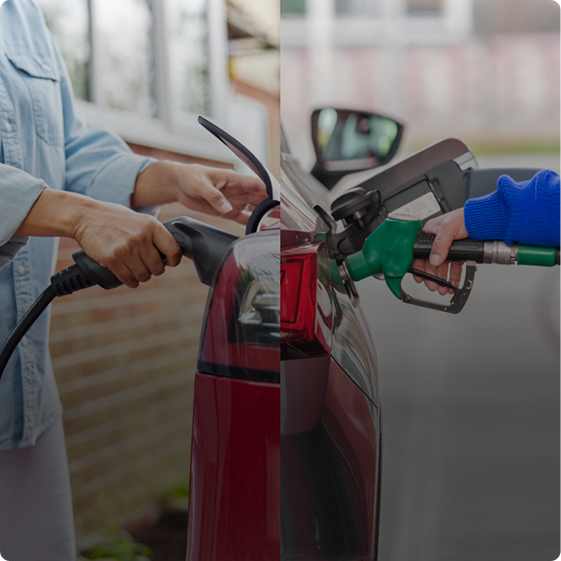EV Charging - As Easy as Just Plugging in
Charging and fueling your car both involve transferring potential power to your vehicle. But that’s where the similarities end.
Learn more

What kind of charger do I need?
An EV charger pulls electrical current from either an outlet or the grid to deliver electricity to the vehicle—like a standard appliance in your home.
Unlike gas pumps, EV chargers come in three varieties—Level 1 (L1), Level 2 (L2), and Direct Current Fast Chargers (DCFC). Each level of charger is identified by the power output expressed in kilowatts (kW).
All mass-produced EV manufacturers provide a L1 charging cord with the purchase of a new vehicle and require no special installation or wiring to charge at home—the charger plugs into a standard 120-volt (V) AC plug. While the charging speed of an L1 charger is slower, it is capable of meeting the needs of many drivers who do not commute long distances everyday.
L2 chargers can be found at home and as public charging stations. L2 chargers use the same type of outlet commonly used for washing machines and other standard household appliances and can be installed at your house by a licensed electrician. Charging to “full” can be accomplished faster than with a L1 charger, meeting the needs of most daily commuters by allowing them to charge to high percentages—or “full”—overnight or while at work.
DCFCs are significantly faster than all other charger types. These chargers tend to be located at public charging stations with multiple ports, similar to traditional gasoline and diesel stations. More and more DCFC stations are being added each week, with ever increasing charging power – chargers are now being offered with speeds of up to 350 kW. These stations are most convenient for drivers traveling long distances and are often co-located with rest areas, stores, or restaurants along major transportation routes. DCFC can charge from 0 to 80 percent charge in roughly 20 minutes.
What are some key terms around EV movement and charging?
Kilowatts (kW) – often refers in EVs to a charging station’s power. This is the rate of energy flow into an EV battery. For example, a fast-charge may be noted as being a 250 kW fast-charger.
Kilowatt-hour (kWh) – this is a quantity of electricity that can be transferred over the course of an hour.
In our example, of a 250 kW charger, if you ran that charger at full capacity for an hour, it would generate 250 kWh of electricity. In reality, EV battery capacities are far smaller and charging power varies over the course of a charging session (sometimes referred to an EV’s charging curve).

Battery capacity – each electric vehicle has a very specific battery capacity within the vehicle that is also measured in kWh. For example, Tesla’s Model Y has a battery capacity of 60 - 75 kWh depending on the trim selected.
EV range – Each electric car has a set mileage that it can run off of a full single charge. This is typically referred to as an ‘EV’s range.” In the Tesla Model Y, the vehicle’s EV range can vary between 280 - 340 mileages on a single charge. This varies depending on both the EV’s battery capacity and whether the vehicle uses all-wheels or just its rear-wheels to drive.
EV efficiency – just as gas cars have differences in miles-per-gallon, EVs have differences in the miles they can travel per kWh. While a standard rule of thumb is 3.3 miles per kWh of battery capacity, in reality some EVs are more efficient and can travel even further, while other larger EVs may move less.
Tax credits from the Inflation Reduction Act (IRA) are available to assist homeowners looking to install a L2 charger until June 30, 2026, and there are many options on the market for Level 2 chargers that can be installed at home. Some localities also provide additional support for homeowners—be sure to check for support in your state.
How much does it cost to charge an EV?
Charging an EV is good for your wallet!
This is because the cost of electricity is consistently lower than gasoline, and experiences far fewer price fluctuations as a result of international events.
Recent studies by groups like the Business Council on Sustainability and BloombergNEF found that on a comparable basis (dollar per gallon of gasoline equivalent) during the first three quarters of 2024, it cost $1.56 to charge an EV nationally, compared to $3.41 per gallon of gasoline for an internal combustion engine vehicle.
At the same time, charging is incredibly convenient. The DOE estimates that 80% of charging is completed at home while the vehicle is parked, due to the low cost and convenience. This means that you may rarely have to make a stop at a public charging station.

Electricity vs Gasoline Calculator
If charging at home, it is important to note that charging rates vary based on demand. Generally, drivers will want to charge their vehicle late at night during “super off-peak” hours to save the most money. Drivers can also check with their local electricity provider to opt-in to managed charging programs and other programs to help transition to at-home charging.
Can I take my EV on a road trip?
Of course!
Road trips are an American past-time and with each passing year, more and more drivers are packing up and driving their EVs across dozens of states.
The U.S. public charging network has improved dramatically in recent years as more and more public chargers are coming online. The Department of Transportation found in 2024 that nearly 1,000 new public EV charging connectors were being added each week.
In total, as of October 2025, there were over 230,000 public EV chargers installed across the country.
Planning your route to align charging with stops to eat, see the sights, and stretch your legs will help reduce the impact on your travel time.



